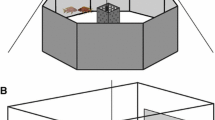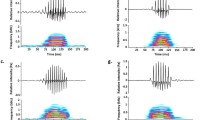Abstract
Playback experiments have been a useful tool for studying the function of sounds and the relevance of different sound characteristics in signal recognition in many different species of vertebrates. However, successful playback experiments in sound-producing fish remain rare, and few studies have investigated the role of particular sound features in the encoding of information. In this study, we set-up an apparatus in order to test the relevance of acoustic signals in males of the cichlid Metriaclima zebra. We found that territorial males responded more to playbacks by increasing their territorial activity and approaching the loudspeaker during and after playbacks. If sounds are used to indicate the presence of a competitor, we modified two sound characteristics, that is, the pulse period and the number of pulses, in order to investigate whether the observed behavioural response was modulated by the temporal structure of sounds recorded during aggressive interactions. Modified sounds yielded little or no effect on the behavioural response they elicited in territorial males, suggesting a high tolerance for variations in pulse period and number of pulses. The biological function of sounds in M. zebra and the lack of responsiveness to our temporal modifications are discussed.




Similar content being viewed by others
References
Amorim MCP (2006) Diversity of sound production in fish. In: Ladich F, Collin SP, Moller P, Kapoor BG (eds) Communication in fishes. Science, Enfield, pp 71–105
Amorim MCP, Almada VC (2005) The outcome of male–male encounters affects subsequent sound production during courtship in the cichlid fish Oreochromis mossambicus. Anim Behav 69:595–601
Amorim MCP, Vasconcelos RO (2008) Variability in the mating calls of the Lusitanian toadfish Halobatrachus didactylus: cues for potential individual recognition. J Fish Biol 73:1267–1283
Amorim MCP, Fonseca PJ, Almada VC (2003) Sound production during courtship and spawning of Oreochromis mossambicus: male–female and male–male interactions. J Fish Biol 62:658–672
Amorim MCP, Knight ME, Stratoudakis Y, Turner GF (2004) Differences in sounds made by courting males of three closely related Lake Malawi cichlid species. J Fish Biol 65:1358–1371
Amorim MCP, Simões JM, Fonseca PJ, Turner GF (2008) Species differences in courtship acoustic signals among five Lake Malawi cichlid species (Pseudotropheus spp.). J Fish Biol 72:1355–1368
Amorim MCP, Simões JM, Mendonça N, Bandarra NM, Almada VC, Fonseca PJ (2010) Lusitanian toadfish song reflects male quality. J Exp Biol 213:2997–3004
Bass AH, McKibben JR (2003) Neural mechanisms and behaviors for acoustic communication in teleost fish. Prog Neurobiol 69:1–26
Bertucci F, Beauchaud M, Attia J, Mathevon N (2010) Sounds modulate males’ aggressiveness in a cichlid fish. Ethology 116:1179–1188
Bertucci F, Attia J, Beauchaud M, Mathevon N (2012) Sounds produced by the cichlid fish Metriaclima zebra allow reliable estimation of size and provide information on individual identity. J Fish Biol 80:752–766
Boersma P, Weenink D (1992–2008) PRAAT, version 5.0.35. www.praat.org
Colleye O, Frederich B, Vandewalle P, Casadevall M, Parmentier E (2009) Agonistic sounds in the skunk clownfish Amphiprion akallopisos: size-related variation in acoustic features. J Fish Biol 75:908–916
Crawford JD, Cook AP, Heberlein CD (1997) Bioacoustic behavior of African fishes (Mormyridae): potential cues for species and individual recognition in Pollimyrus. J Acoust Soc Am 102:1200–1212
De Jong K, Bouton N, Slabbekoorn H (2007) Azorean rock-pool blennies produce size-dependent calls in a courtship context. Anim Behav 74:1285–1292
Delco EA Jr (1960) Sound discrimination by males of two cyprinid fishes. Tex J Sci 12:48–54
Edds-Walton PL, Mangiamele LA, Rome LC (2002) Variations of pulse repetition rate in boatwhistle sounds from oyster toadfish Opsanus tau around Waquoit Bay, Massachusetts. Bioacoustics 13:153–173
Galhardo L, Correia J, Oliveira RF (2008) The effect of substrate availability on behavioural and physiological indicators of welfare in the African cichlid (Oreochromis mossambicus). Anim Welf 17:239–254
Galhardo L, Almeida O, Oliveira RF (2009) Preference for the presence of substrate in male cichlid fish: effects of social dominance and context. Appl Anim Behav Sci 120:224–230
Gerald JW (1971) Sound production during courtship in six species of sunfish (Centrarchidae). Evolution 25:75–87
Ibara RM, Penny LT, Ebeling AW, Van Dykhuisen G, Cailliet G (1983) The mating call of the plainfin midshipman fish, Porichthys notatus. In: Noakes DLG, Lindquist DG, Helfman GS, Ward JA (eds) Predators and preys in fishes. Dr. W. Junk, The Hague, pp 205–212
Ladich F (1997) Agonistic behaviour and significance of sounds in vocalizing fish. Mar Freshw Behav Physiol 29:87–108
Ladich F (1998) Sound characteristics and outcome of contests in male croaking gouramis (Teleostei). Ethology 104:517–529
Ladich F, Myrberg AA Jr (2006) Agonistic behavior and acoustic communication. In: Ladich F, Collin SP, Moller P, Kapoor BG (eds) Communication in fishes. Science, Enfield, pp 121–148
Ladich F, Brittinger W, Kratochvil H (1992) Signifance of agonistic vocalization in the croaking gourami (Trichopsis vittatus, Teleostei). Ethology 90:307–314
Lobel PS (2001) Acoustic behaviour of cichlid fishes. J Aquac Aquat Sci 9:167–186
Lugli M (1997) Response of male goby, Padogobius martensii, to aggressive sound playback following pre-experimental visual stimulation. Behaviour 134:1175–1188
Lugli M, Pavan G, Torricelli P (1996) The importance of breeding vocalizations for mate attraction in a freshwater goby with a composite sound repertoire. Ethol Ecol Evol 8:343–351
Lugli A, Pavan G, Torricelli P (2004) The response of the male freshwater goby to natural and synthetic male courtship sound playback following exposure to different female sexual stimuli. Ethol Ecol Evol 16:55–70
McGregor PK (1992) Playback and studies of animal communication. Plenum Press, New York
McKibben JR, Bass AH (1998) Behavioral assessment of acoustic parameters relevant to signal recognition and preference in a vocal fish. J Acoust Soc Am 104:3520–3533
McKibben JR, Bass AH (2001) Effects of temporal envelope modulation on acoustic signal recognition in a vocal fish, the plainfin midshipman. J Acoust Soc Am 109:2934–2943
Morton ES (1977) On the occurrence of significance of motivation—structural rules in some birds and mammals sounds. Am Nat 111:855–869
Myrberg AA Jr, Lugli M (2006) Reproductive behavior and acoustic communication. In: Ladich F, Collin SP, Moller P, Kapoor BG (eds) Communication in fishes. Science, Enfield, pp 149–176
Myrberg AA Jr, Spires JY (1972) Sound discrimination by the bicolor damselfish, Eupomacentrus partitus. J Exp Biol 57:727–735
Myrberg AA Jr, Spanier E, Ha SJ (1978) Temporal patterning in acoustic communication. In: Reese ES, Lighter FJ (eds) Contrasts in behaviour. Wiley, New York, pp 137–179
Myrberg AA Jr, Mohler M, Catala JC (1986) Sound production by males of a coral reef fish (Pomacentrus partitus): its significance to females. Anim Behav 34:923–933
Oliveira RF, Almada VC (1996) Dominance hierarchies and social structure in captive groups of the Mozambique tilapia Oreochromis mossambicus (Teleostei Cichlidae). Ethol Ecol Evol 8:39–55
Ottoni EB (1995–1999) Etholog 2.2 (Ethological Transcription Tool), version 2.2.5. www.ip.usp.br/ebottoni/EthoLog/ethohome
Parmentier E, Kéver L, Casadevall M, Lecchini D (2010) Diversity and complexity in the acoustic behavior of Dacyllus flavicaudus (Pomacentridae). Mar Biol 157:2317–2327
Rigley L, Muir J (1979) The role of sound production by the brown bullhead Ictalurus nebulosus. Proc Pa Acad Sci 53:132–134
Rollo A, Higgs D (2008) Differential acoustic response specificity and directionality in the round goby, Neogobius melanostomus. Anim Behav 75:1903–1912
Schwarz A (1974) The inhibition of aggressive behaviour by sound in the cichlid fish, Cichlasoma centrarchus. Z Tierpsychol 35:508–517
Simões JM, Duarte IG, Fonseca PJ, Turner GF, Amorim MCP (2008) Courtship and agonistic sounds by the cichlid fish Pseudotropheus zebra. J Acoust Soc Am 124:1332–1338
Spanier E (1979) Aspects of species recognition by sounds in four species of damselfishes, genus Eupomacentrus (Pisces: Pomacentridae). Z Tierpsychol 51:301–316
StatSoft Inc. (2004) STATISTICA (data analysis software system), version 6. www.statsoft.com
Stout JF (1963) The significance of sound production during the reproductive behaviour of Notropis analostanus (Family Ciprinidae). Anim Behav 11:83–92
Suzuki A, Kozloski J, Crawford JD (2002) Temporal encoding for auditory computation: physiology of primary afferent neurons in sound-producing fish. J Neurosci 22:6290–6301
Thorson RF, Fine ML (2002) Acoustic competition in the gulf toadfish Opsanus beta: acoustic tagging. J Acoust Soc Am 111:2302–2307
Vasconcelos RO, Fonseca PJ, Amorim MCP, Ladich F (2011) Representation of complex vocalizations in the Lusitanian toadfish auditory system: evidence of fine temporal, frequency and amplitude discrimination. Proc R Soc B 278:826–834
Verzijden MN, van Heusden J, Bouton N, Witte F, ten Cate C, Slabbekoorn H (2010) Sounds of male Lake Victoria cichlids vary within and between species and affect female mate preferences. Behav Ecol 21:548–555
Winn HE (1967) Vocal facilitation and the biological significance of fish sounds. In: Tavolga WN (ed) Marine Bioacoustics, vol 2. Pergamon, Oxford, pp 213–230
Winn HE (1972) Acoustic discrimination by the toadfish with comments on signals systems. In: Winn HE, Olla BL (eds) Behavior of marine animals, volume 2: vertebrates. Plenum, New York, pp 361–385
Wysocki LE, Ladich F (2003) The representation of conspecific sounds in the auditory brainstem of teleost fishes. J Exp Biol 206:2229–2240
Acknowledgments
The authors would like to thank Nicolas Boyer and Colette Bouchut for their technical support. We are grateful to Christina Meier, Friedrich Ladich and an anonymous referee for their comments on previous versions of the manuscript. F. B. was supported by a Ph.D. fellowship from the French Ministère de l’Enseignement Supérieur et de la Recherche. This study was funded by the Institut Universitaire de France (N. M.), the Centre National de la Recherche Scientifique and the University of Saint-Etienne.
Author information
Authors and Affiliations
Corresponding author
Electronic supplementary material
Below is the link to the electronic supplementary material.
10071_2012_549_MOESM1_ESM.pdf
Supplementary material 1 (PDF 73 kb): Oscillograms of a sound produced by a male M. zebra during an agonistic interaction (a) before playing it back, and (b) once played back through our broadcasting apparatus (recorded at 15 cm from the loudspeaker, within the aquarium filled with water). For each oscillogram, the detail of a pulse is shown. Two variables (mean frequency and pulse period) of 10 randomly selected sounds were compared before and after playback. A paired t test revealed no significant differences in the mean frequency (n = 10, t = 1.91, p = 0.09) nor in the pulse period (n = 10, t = 1.25, p = 0.24)
Rights and permissions
About this article
Cite this article
Bertucci, F., Attia, J., Beauchaud, M. et al. The relevance of temporal cues in a fish sound: a first experimental investigation using modified signals in cichlids. Anim Cogn 16, 45–54 (2013). https://doi.org/10.1007/s10071-012-0549-z
Received:
Revised:
Accepted:
Published:
Issue Date:
DOI: https://doi.org/10.1007/s10071-012-0549-z




